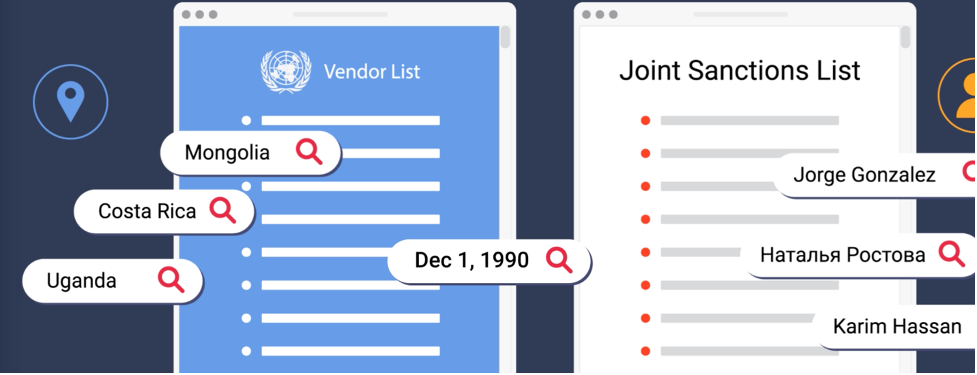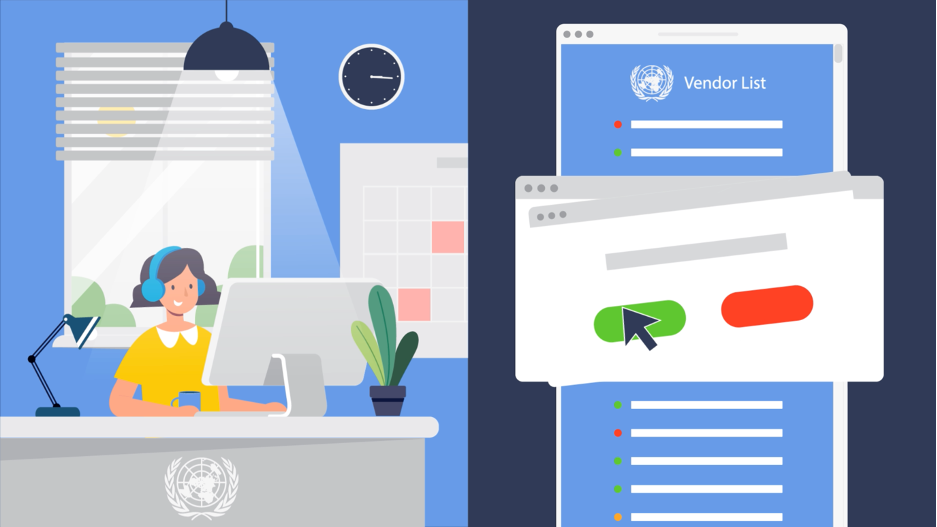A robotic process automation solution for UN joint sanctions screening lists
The UN Digital Solutions Centre (UN DSC), operated in partnership by the UN World Food Programme (WFP) and the UN High Commissioner for Refugees (UNHCR), supported by UNICC, has developed a Joint Sanctions Screening solution using Robotic Process Automation (RPA) to streamline repetitive, manual and inefficient vendor screening processes.
The United Nations family is, among many other things, stewards of public funds for social good. It depends on partners who hire people, exchange monies and deliver goods and services, awarding contracts through fair and effective competition.
High standards of integrity and compliance mean zero tolerance for fraud and corruption. The UN minimizes fraud by imposing sanctions on potential vendors, partners and their employees.
Each UN organization maintains its own and ever-changing vendor lists that need to be checked against numerous international sanctions lists. The vetting process is often manual, time-consuming and comes at late stages of procurement, leading to errors and duplication of efforts.
The UN DSC took up the challenge to find a better way with the UN Joint Sanctions Screening solution.
Credit: Denian Ouyang, Animator
UNHCR and WFP explored digital automation solutions for these routine transactional processes, screening prospective vendors, employees, consultants, contractors, or other cash recipients or beneficiaries against discrete UN sanctions lists. For procurement staff, this type of screening involves manually intensive data validations and tedious rules-based tasks critical to compliance and security.
A Robotic Process Automation (RPA) solution works round the clock to:
- Enhance compliance reporting, early detection of fraud and security control
- Free up the time of skilled resources for value-adding activities
- Improve the quality, accuracy, efficiency and speed of work
- Reduce operational costs (i.e., fixed price for core product, with option to customize and enhance per organizational requirements).
How it works
For each member Agency, the screening solution uses a bot to download the latest international sanctions lists once a day and consolidate them into a single master checklist.

Credit: Denian Ouyang, Animator
It compares the list of vendors to this joint sanctions checklist, filtering by organizational names, Individuals’ names, nationalities, dates of birth and other information. The screening tool reports on sanctions matches and shares results with the member Agency business team, who can add their own vendor or organizational data to the output. It streamlines the work of the business team, who is freed up to focus on analysing the data, approving or denying bids from vendors.
While analysts sleep restfully at night, each Agency’s bot keeps on churning and working. From a business standpoint, the Joint Sanctions Screening solution has been delivering value since April 2019: it has simplified, standardized and automated the common sanction screening process, yet it accommodates each Agency’s unique screening parameters. In the first year alone, this UN Joint Sanctions Screening solution performed over 150 billion comparisons for member organizations.
Shared and customized solutions
The solution also supports screening against internal organizational lists. If an organization wishes to screen against only one or two of these lists – or against any other list, such as vendors rejected by other organizations – then the solution is easily configurable. The bot has separate credentials for each of the business applications it engages, so that users can trace and audit all the bot’s actions using predefined reporting templates. Since it’s a shared solution, the costs for using it are much lower for everyone. And it’s easy to use!
From a technical standpoint, the Joint Sanctions Screening solution is flexible, designed to integrate easily into the system of any UN Agency. It features a single platform so that UN Agencies can cooperate more easily, with customized screening parameters for any UN Agency that wishes to participate and consume this service.
The Joint Sanctions Screening solution is up and running for UNHCR and WFP, fully ready to deliver to scale to other organizations through UNICC’s Hyper-Automation Centre of Excellence. The Food and Agriculture Organization (FAO) recently subscribed and other Agencies are exploring opportunities made possible by this solution.
The RPA team is only a ping away. Please reach out to [email protected] for a demonstration. The UN DSC and UNICC are happy to extend a test environment to acquaint Clients and Partner Organizations with the UN Joint Sanctions Screening solution.
The UN Joint Sanctions Screening solution, optimising back-office operations and bringing peace of mind to managing public funds for social good, unlocking the promise of the SDGs.
About the digital solutions centre
The United Nations Digital Solutions Centre is operated in partnership by the UN World Food Programme (WFP), the UN High Commissioner for Refugees (UNHCR) and is supported by the UN International Computing Centre (UNICC). By leveraging new technologies and UN expertise, the UN Digital Solutions Centre aims to create a suite of digital solutions that can be shared among UN agencies to transform common business operations and streamline time-consuming transactional tasks. Solutions developed by WFP and UNHCR will be made available to the entire UN system.

